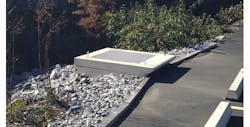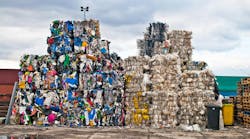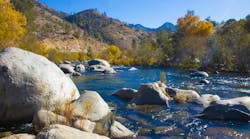Green & Grey
The Thomas R. Beecher Jr. Innovation Center—located in the heart of the Buffalo Niagara Medical Campus (BNMC) in downtown Buffalo, N.Y.—is a state-of-the-art, LEED-certified building with a collaborative environment designed to foster innovation and creativity. This site is an example of adaptive reuse and the ongoing renaissance of western New York, as the century-old industrial powerhouse is being transformed and revitalized.
Created in 2001, the BNMC is comprised of 6.5 million sq ft of clinical, research and support space on over 120 acres dedicated to the cultivation of a world-class medical campus for patient care, research, education and entrepreneurship. Immediate investment and growth has been planned, with more than 2 million sq ft currently or soon to be under construction, equaling an investment of $750 million in private and public funding.
This redevelopment site is comprised of approximately 2 acres (0.8 ha) of impervious surface, including sidewalks and asphalt pavement. Initially, a bioretention facility was proposed as the water quality and volume treatment practice.
This project came about as a result of the City of Buffalo being under a federal mandate to reduce the volume of combined sewer overflow entering the Buffalo River.
“We explored traditional grey infrastructure options for storm water on this site,” said Mark McGovern, senior project manager at the Innovation Center. “At the time, it had no catch basins, and sheet drained to the southern end of the lot. Rather than redirect the water through traditional grey infrastructure, we looked to deploy green in combination with grey infrastructure for both aesthetic and environmental considerations. The volume of rainwater held on site and pollutants removed from the surface overflow via the Jellyfish Filter not only provide benefit to the medical campus, but [also] directly improves the visitor experience at Canalside, one of Buffalo’s emerging centers of recreation and commerce. This is due to the fact that previously, the combined sewer overflow this lot would eventually feed would enter the Buffalo River at Canalside.”
After reviewing the New York State Department of Environmental Conservation (NYSDEC) Stormwater Management Design Manual requirements for biorentention as a storm water management practice, the Sustainable Resource Group—in cooperation with the Innovation Center—elected to use a green and grey approach by incorporating a Jellyfish Filter curb inlet unit as pretreatment to the bioretention cell.
The site design included a large asphalt parking lot graded to direct runoff and snow melt toward the Jellyfish Filter unit, which is located just prior to the bioretention cell. The compact 4-ft-by-4-ft unit houses three membrane cartridges with a total filtration surface area of 847 sq ft (79 sq m). It is designed to accept runoff through a curb inlet with a driving head of 12 in. (305 mm), provide treatment and then discharge treated water through an open back over riprap into the bioretention cell. The bioretention cell extends the full width of the parking lot, approximately 200 ft (60 m), with a filtration surface area of 1900 sq ft (177 sq m).
Combining grey treatment technology with green treatment practices as part of a treatment train approach offers several benefits. Using the Jellyfish Filter to pre-treat bioretention on a site with limited available drop makes the flexibly designed Jellyfish Filter a good fit. The unit’s placement, along the curb line with a hatch, provides a single point of access for easy inspection and maintenance.
When considering the urban setting and snowmelt pollutant loading, the treatment approach provides trash and debris removal, making the overall site more aesthetically pleasing while extending the service life of the bioretention cell. This keeps the long-term cost of inspection and maintenance to a minimum. Without the curbside pretreatment, unsightly debris, hydrocarbons and sediment could easily clog the bioretention’s surface filtration area and create an eyesore. This Jellyfish Filter catch-basin configuration requires no confined space entry for inspection or maintenance. The membrane cartridges are lightweight and easy to remove, rinse, reuse and eventually replace.
“Personally, I was amazed at the ease with which the membrane cartridges were removed from the concrete vault,” said McGovern. “I was also taken aback at the amount of sediment and pollutants retained in the cartridges.”


